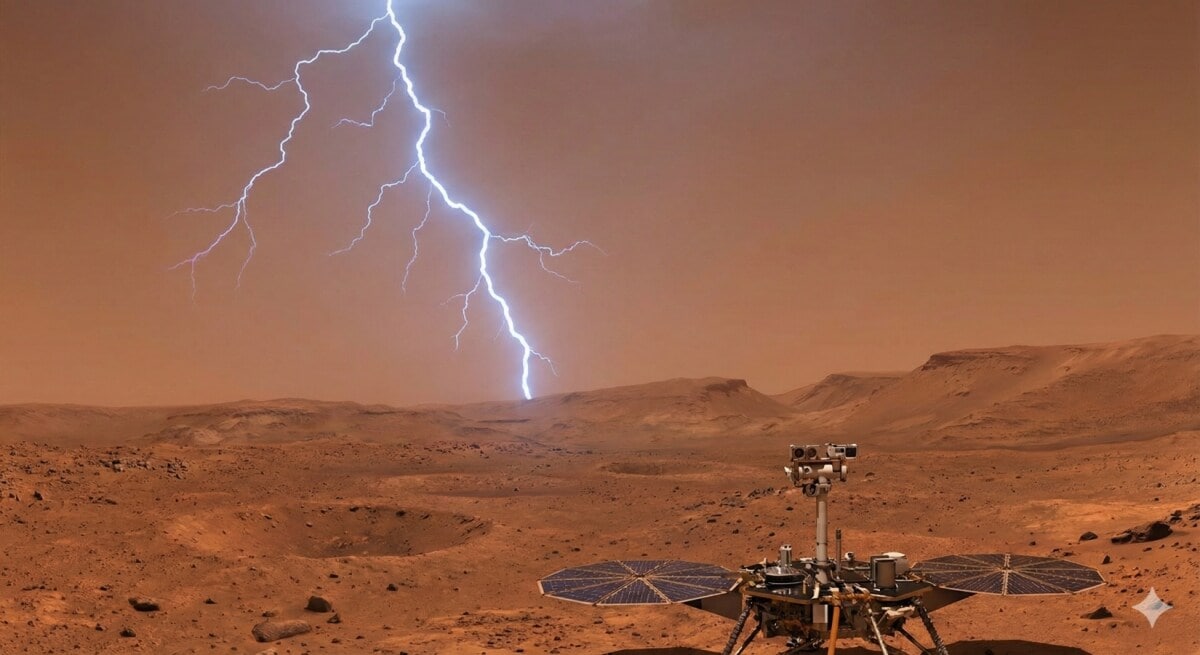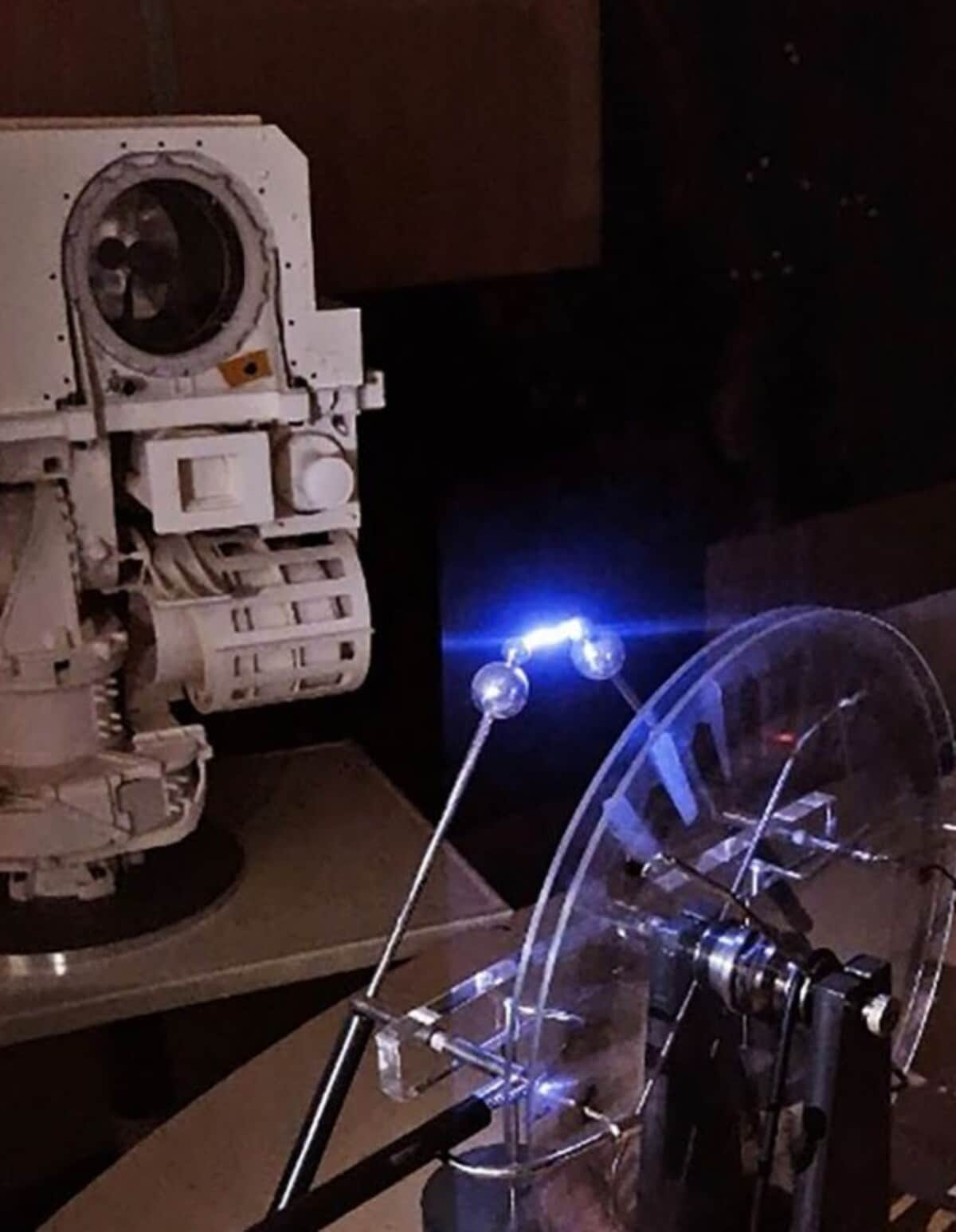Last Updated:November 28, 2025, 12:19 IST
NASA’s Perseverance rover has recorded lightning and thunder on Mars for the first time, revealing the Red Planet’s electrifying and mysterious storms

This breakthrough deepens understanding of Martian weather, highlighting future exploration risks and the possible role of electricity in the origins of life. (AI Generated)
Mars is renowned for its silence, and that silence has now been shattered by a remarkable discovery: lightning on the Red Planet. NASA’s Perseverance rover has achieved what was long thought impossible, providing the first-ever direct evidence of electrical discharges on Mars.
The question of whether lightning exists on Mars has intrigued scientists for centuries. Perseverance has now answered it. For the first time, researchers have heard the sound of an electrical discharge on Mars, revealing a phenomenon vastly different from terrestrial lightning.
Unlike Earth, the Martian atmosphere is dry and thin, and the discharges occur in the presence of dust storms, often referred to as dust devils.

Over the course of two Martian years, lightning has been recorded 55 times during these dust storms, highlighting the planet’s mysterious and electrified environment.
How Can Lightning Form Without Clouds?
Mars has no water clouds, and its atmosphere is exceedingly dry. The answer lies in the dust. When dust particles collide in the atmosphere, friction generates an electrical charge, a process known as the triboelectric effect, akin to rubbing a balloon on hair to generate static electricity. This effect, magnified by dust devils and sandstorms, produces the electrical discharges observed.
While similar phenomena occur on Earth, such as lightning from volcanic ash or sandstorms, they are less obvious. Mars’s atmosphere, dominated by carbon dioxide and much thinner than Earth’s, allows charges to accumulate near the surface, making the events detectable by Perseverance.
Lightning Across The Solar System
Lightning is not unique to Mars. Jupiter and Saturn both experience frequent strikes, and evidence of lightning has been found on Uranus and Neptune. Venus remains under debate.

Each planet’s atmosphere influences how electricity is generated, and on Mars, the highest atmospheric pressure near the surface makes it the most likely region for lightning. Perseverance captured these discharges precisely in this zone.
SuperCam Captures The Unheard Sound
The discovery was made possible by the SuperCam microphone on Perseverance, led by scientist Baptiste Chaide of the University of Toulouse, France. The microphone records both sound and electromagnetic waves, enabling researchers to detect subtle electrical activity amid the noise of dust storms.
The team analysed 28 hours of recordings, searching for distinctive signals among the ambient storm sounds. They identified 55 separate events, characterised by an initial electronic ‘blip’ followed by a brief ringing sound lasting 8 milliseconds. Seven events were fully recorded, including small sonic booms, or miniature thunderclaps, caused by the lightning heating the air. This represents the first ‘thunder-like’ sound ever recorded on Mars.

To ensure accuracy, the researchers conducted Earth-based experiments. They built a replica of SuperCam and simulated electrical discharges in the lab. The resulting recordings matched perfectly with the Martian data, confirming that the rover had indeed captured real lightning events rather than technical artefacts or noise.
Wind: The Essential Factor
Dust alone cannot produce Martian lightning. The data revealed that strong winds were necessary. Of the 55 events, 54 occurred during the planet’s strongest wind conditions, showing that lightning discharges happen only at the peak of dust storms.
Dust devils themselves were responsible for 16 events, demonstrating that even smaller whirlwinds can generate significant electrical activity.
Nanojoules V/S Billions Of Joules
Martian lightning is far weaker than on Earth. Six discharges were extremely weak, ranging from 0.1 to 150 nanojoules, while one large discharge reached 40 millijoules, possibly originating from static accumulation on the rover itself.
By comparison, Earth lightning releases billions of joules, making Martian lightning much less dangerous to humans but still capable of damaging robotic equipment.
This discovery serves as a critical warning for future exploration. Robotic missions and potential human explorers will need technology capable of withstanding Martian electrical activity. Understanding lightning on Mars also informs atmospheric models and the study of chemical reactions occurring there, ensuring better-prepared missions in the future.
Lightning And The Origins Of Life
Electricity is believed to have been crucial in the origin of life on Earth, combining lifeless molecules to spark the first organisms, a concept sometimes referred to as the ‘Frankenstein Theory’. The presence of lightning on Mars suggests that similar processes could have occurred there, offering new hope for the possibility of life.
Astrobiologists are now factoring Martian electrical phenomena into their calculations, increasing the prospect that electricity may have sparked life on the planet billions of years ago.

Publication And Future Prospects
The study has been published in the prestigious journal Nature, with Chaide and colleagues emphasising that this opens new avenues for research. The Perseverance rover remains active, continuing to record Martian sounds and electrical phenomena.
With each new discovery, Mars gradually unveils its secrets, and scientists around the world watch in anticipation, eager to see what the Red Planet will reveal next.
Red Planet Day
Red Planet Day is observed globally on November 28 to honour our intriguing planetary neighbour, Mars. The day coincides with the 61st anniversary of the launch of Mariner 4, NASA’s first successful mission to fly by the red planet. The Mariner 4 mission, launched on November 28, 1964, is central to Red Planet Day celebrations. Nearly a year later, on July 14, 1965, the spacecraft became the first to successfully fly by Mars. It marked a historic milestone, providing the first-ever close-up images of Mars and its surroundings.
This pioneering mission laid the foundation for subsequent Mars exploration, enabling orbiters, landers, and rovers to gather critical data and paving the way for potential human exploration and colonisation.
Milestones In Mars Exploration
Since Mariner 4, numerous missions have expanded our knowledge of Mars:
1971: The first successful soft landing on Mars, a major milestone in human exploration.1975: Viking 1 and 2 landed on Mars, sending back high-resolution images and conducting life-search experiments.2003: ESA’s Mars Express orbited Mars to collect further data.2004: NASA’s Spirit and Opportunity rovers found evidence of past water activity, revealing Mars’ habitability potential.2012: Curiosity Rover landed to study the Martian surface and subsurface, continuing the legacy of exploration.These missions have transformed Mars from a distant object of curiosity to a prime candidate for human exploration.
Location :
United States of America (USA)
First Published:
November 28, 2025, 12:19 IST
News world Doomsday Lightning On Mars! NASA Rover Records Terrifying Sounds On The Red Planet For The First Time
Disclaimer: Comments reflect users’ views, not News18’s. Please keep discussions respectful and constructive. Abusive, defamatory, or illegal comments will be removed. News18 may disable any comment at its discretion. By posting, you agree to our Terms of Use and Privacy Policy.
Read More

 45 minutes ago
45 minutes ago

















